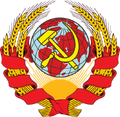| The following New Union page is under construction.
Please do not edit or alter this article in any way while this template is active. All unauthorized edits may be reverted on the admin's discretion. Propose any changes to the talk page. |
The following article is a list of political parties in the Soviet Union. The Union of Soviet Sovereign Republics is a liberal democracy and a multi-party state. There currently exists dozens of registered political parties within the USSR, with three of which (the Communist Party, the Democratic Party, and the Liberal Party) having established dominance since the late 1990s.
Prior to the 1990s, the Soviet Union was a single-party state, dominated solely by the Communist Party. This came to an end in the late 1980s, with the Liberal Democratic Party becoming the second registered party of the Soviet Union in 1989.
Currently Represented in the Supreme Soviet[]
Communist Party[]

The hammer and sickle is commonly used as the symbol for the Communist Party.
The Communist Party of the Soviet Union (Russian: Коммунистическая партия Советского Союза, Kommunistichyeskaya partiya Sovyetskogo Soyuza), commonly abbreviated as the CPSU (КПСС, KPSS), is a center-left to left-wing political party of the Soviet Union. The Communist Party currently promotes a platform centered on democratic socialism and left-wing populism, and some elements of Marxism-Leninism. The Communists favor the nationalization of key industries within the Soviet Union (while allotting privatization for small businesses), the establishment of a welfare state, the protection of multiculturalism and secularism.
The Communist Party was founded in 1912 by Vladimir Lenin as a minor political movement within the Russian Empire. The party supported the teaching of Karl Marx under the framework of democratic centralism. The movement soon dominated Russia following the October Revolution in 1917, and would become the only allotted party within the newly formed Soviet Union until the late 1980s. Throughout the 1990s and 2000s, the party began to reform their policies away from hardline communism and more towards the social democratic leanings of Mikhail Gorbachev (eliminating much of the negativity once associated with the Communists).
The Communist Party of currently has membership in both the International Meeting of Communist and Workers' Parties (IMCWP) and Socialist International, as well as friendly relations with the Party of the European Left within the European Union. The CPSU continues to own and operate the political newspaper Pravda, which continues to promotes the party's platforms (though has lost much of its national following since the 1990s). The All-Union Leninist Young Communist League (also known as Komsomol) is the youth wing of the CPSU.
As part of the Supreme Soviet elections of 2009, the Communists and the Liberals came together and established a center-left political bloc (known as "Our Union") to challenge the Democrats (who gained the majority in 2004). The bloc formed a coalition government in both chambers for the 15th (2009-2014) and the 16th (2014-2019) sessions of the Supreme Soviet.
Liberal Party[]
The Liberal Party of the Soviet Union (Russian: Либеральная партия Советского Союза, Libyeral'naya partiya Sovyetskogo Soyuza), commonly abbreviated as the LPSU (ЛПСС, LPSS), is a centrist to center-left political party of the Soviet Union. The Liberal Party promotes a platform centered on centrism, economic and social liberalism, libertarianism, pragmatism, and Third Way politics. Liberals favor the expansion and protection of civil liberties for all people of the USSR. The party is notorious for being pro-capitalism and favoring further privatization of the Soviet economy.
The Liberal Party was established in 1999 following the dissolution of the Liberal Democratic Party (including much of the moderate elements of the former LDPSU). Under the leadership of Yuri Luzhkov, the LPSU established itself as a moderate party compared to the radical elements promoted by the Communists and Democrats.
| |||||||||||||||||

